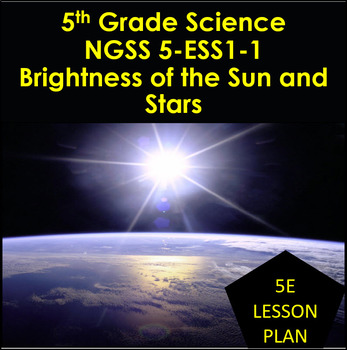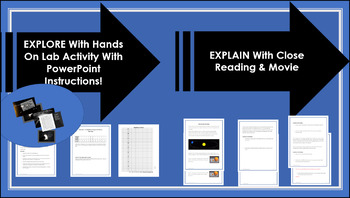5th Grade Science NGSS 5-ESS1-1: Brightness of the Sun and Stars
- Zip
What educators are saying
Also included in
- These units are especially designed for teachers using NGSS. These are phenomena-based lessons that are in 5E format. Units cover Matter and Its Interactions, Gravity, Photosynthesis, Energy, Ecosystems, Earth’s Place in the Universe, Earth Systems, and Earth and Human Activity. Be sure to checkPrice $91.08Original Price $113.85Save $22.77
- NGSS 5-ESS1-1 and NGSS 5-ESS1-2 5E Lesson Plans are included in this Bundle. These lessons plans are designed to be fun and engaging for your students.Product Descriptions NGSS 5-ESS1-1 Brightness of the Sun and Stars – Support an argument that differences in the apparent brightness of the sun compPrice $12.20Original Price $15.25Save $3.05
Description
5th Grade Science NGSS 5-ESS1-1 Brightness of the Sun and Stars is an engaging and interesting lesson which includes videos, engaging PowerPoint presentations, a lab, and science literacy reading. This lesson is in 5E format, and is aligned with NGSS Standard 5-ESS1-1 as well as Common Core Standards for ELA and Mathematics.
This unit is for 5th grade NGSS Performance Expectation 5-ESS1-1. Support an argument that differences in the apparent brightness of the sun compared to other stars is due to their relative distances from the Earth.
This unit also covers the NGSS Science and Engineering Processes of
• Represent data in graphical displays
• Engaging in argument from evidence
• Support argument with evidence
The 5E steps are:
Engage: Students watch a PowerPoint presentation with a video link on the sun and stars.
Explore: Here students will perform a lab experiment using easily available materials and a flashlight. They make and record measurements, then graph their data and interpret what the data is telling them. Separate data sheets and graph paper are provided for collecting and charting their data.
Explain: The students will read a passage on the sun and stars and watch another video. The students will also answer questions on the reading. Answer keys are provided.
This reading supports science literacy reading, reading for non-fictional information, and ELA close reading.
Elaborate: Three elaboration activities are provided.
Evaluation: The students will then prepare an argumentative essay stating what they believe based on what they learned, and supporting their statements with evidence they gathered from the 5E process.
Directions for the essay are included in the Teacher Notes. The students must use evidence to support their statements.
Detailed Teacher notes have been provided to cover all aspects of this unit and the Essay instructions.
==================================================================================
What you will get in this Package:
An introduction PowerPoint and an engaging introduction video
A lab exercise to produce, record and graph datadata sheet and graph paper is also provided
A reading that meets science literacy requirements and a second video
Assessment questions for the reading with answer key
Instructions for every step in the 5E process
==================================================================================
This Product also supports the following Common Core Standards:
ELA/Literacy
RI.5.1 – Quote accurately from a text when explaining what the text says explicitly and when drawing inferences from the text.
RI 5.7 – Draw on information from multiple print or digital sources demonstrating the ability to locate an answer to a question quickly or to solve a problem.
RI.5.9 – Integrate information from several texts in the same topic in order to write or speak about the subject knowledgably.
Mathematics
5.G.A.2 – Represent real world and mathematical problems by graphing points in the first quadrant of the coordinate plane and interpret coordinate values of points in the context of the situation.
For additional products, please check out our TPT store at:
Note: Next Generation Science Standards is a registered trademark of Achieve. Neither Achieve nor the lead states and partners that developed the Next Generation Science Standards were involved in the production of this product, and do not endorse it.”







